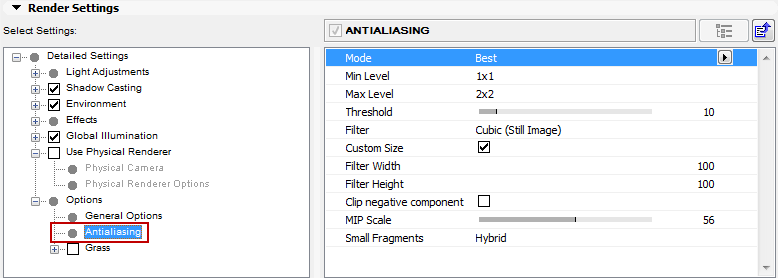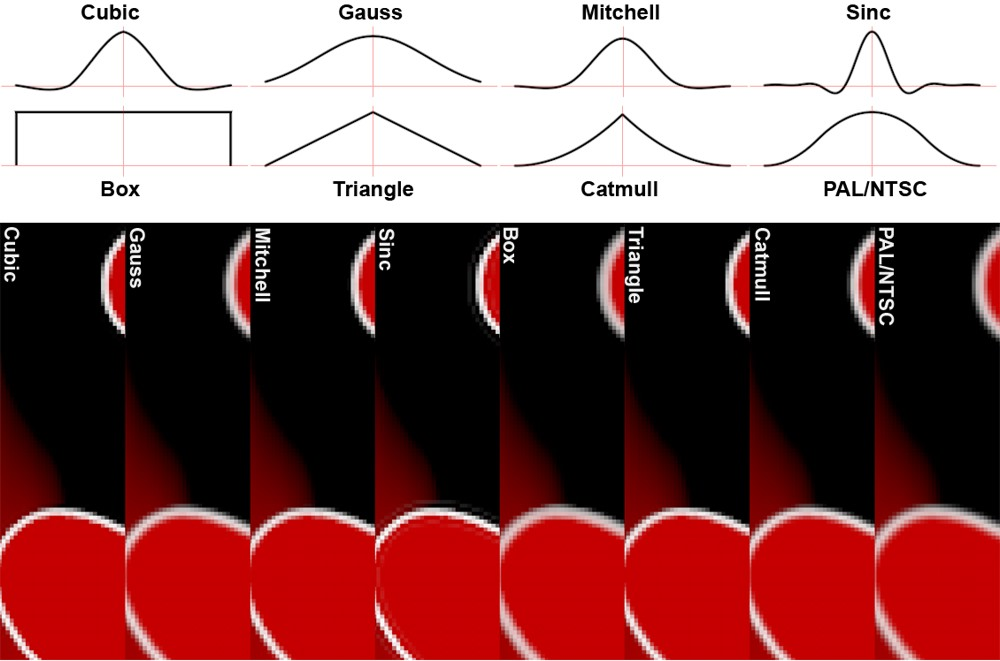
Antialiasing is used with the Standard Renderer.

Antialiasing removes jagged edges from your images. It works by breaking down each pixel into sub-pixels; rather than calculate just one color for a pixel, several color values are calculated and averaged to produce the final color for the pixel.
Mode
Choose None, Geometry or Best.
From left to right: None, Geometry (the slightly blurred texture is a result of the antialiasing filters) and Best antialiasing.

•None: The image to be output will be calculated without antialiasing (any existing Render controls with differing settings will be ignored). Step-like structures will be recognizable at object and color edges. This mode is particularly suited for fast test renderings for which quality is not important.
•Geometry: This is the default setting which smooths all object edges (automatically with 16x16 sub-pixels).
•Best: This enables (in addition to object smoothing) adaptive antialiasing (additional sub-pixels will only be calculated at critical regions, i.e. for pixels whose color differs greatly from those of its neighboring pixels), which affects color edges (e.g. also shadows, objects behind transparencies, etc.). This in turn is controlled via several parameters available for this mode.
Higher antialiasing settings are often only noticeable in the finer details.
Min Level/Max Level/Threshold
The default combination of these three parameters will be fine in most cases.
These settings control CineRender’s adaptive antialiasing (set Best mode, above). Sub-pixels will be calculated for neighboring pixels whose color differs too greatly; for non-critical regions (large, uniformly colored regions) no sub-pixels will be calculated if at all possible.
Adaptive antialiasing only works for color edges or object edge smoothing for objects that lie behind transparent objects or in reflections.
Min Level defines the minimum number of sub-pixels that will always be rendered. The default value of 1.1 will suffice for most cases. If, however, artifacting should occur in very detailed regions, e.g. shadow elements get swallowed, higher values should be used.
Max Level is the sub-pixel dispersion that is applied to critical regions (mostly high-contrast regions, i.e. color edges or object edges behind transparencies). This value can, for example, be increased when rendering glass to ensure the rendering of finer details.
The Threshold value defines the degree of color divergence at which Max Level should be applied for a given pixel. Small values will allow no divergence, large values will allow greater contrasts before smoothing begins.

In an average scene with a Threshold (Color) value of 10%, about 40% of all pixels will be affected, whereas a Threshold value of 5% will result in 90% of all pixels being affected. A value of 0% will cause all pixels of a rendered image to be antialiased - including superfluous regions.
These three parameters greatly influence the render speed! Settings that are too high can easily increase render times tenfold, without much noticeable difference in render quality. The default values offer very good results in most cases, with moderate render times.

Generally speaking, the filter controls how sharp and crisp the edges will be rendered.
The filter works with both Geometry (object edge smoothing) and Best (color edge smoothing) antialiasing modes. In most cases, the filter selection has little effect on the render speed.
A brief explanation of how the antialiasing filter works: Depending on the antialiasing settings, a number of subpixels will be calculated per pixel whose colors are then pooled for that pixel (a pixel can only have a single color).
![]()
In the image above are 9 edge pixels that run diagonally across the image. Take a look at the center pixel. 16 sub-pixels were used to calculate this pixel. 15 are light gray, 1 red. These pixels form a curve (Mitchell in this case). Imagine this curve as flat around the center of a pixel. This curve then defines the degree of influence each sub-pixel should have. Because the filter size (Filter Width setting) and Filter Height (i.e. the spread within which sub-pixels will be taken into consideration) can be expanded to up to 4 pixels, the curve can be made to spread out quite a bit more. Conversely, this means that neighboring pixels for the most part see the same sub-pixel and therefore have a very similar color. Of course edges can then no longer be made to look sharp and crisp.
Each choice in the filter pop-up represents a different curve, defining the degree of influence each sub-pixel should have.

•Filter Width/Filter Height: Filter Width/Height defines how many sub-pixels (calculated from the center of the pixel outwards) will be taken into consideration when the pixel color value is calculated.
•As long as the Custom Size option is enabled, an ideal value for Filter Width and Filter Height will be used, which will also be displayed. The values are in relation to the pixel, i.e. a value of 0.5 for both parameters means that sub-pixels 0.5 to the left and right, and 0.5 above and below the pixel center point will be taken into consideration, i.e. all sub-pixels on the pixel surface. Higher values will extend to surrounding pixels accordingly, which will result in color edges being rendered correspondingly less sharply.
•Clip Negative Component: A filter function’s negative regions can be clipped.
In the image above, you will notice that several curves (Mitchell, Cubic and in particular Sinc) even fall below zero. This means that at corresponding edges, contrasting color values are rendered that are not even present in the scene. This makes the edges look sharper. This can, however, lead to problems under certain circumstances. If the Clip Negative Component option is enabled, the negative regions will be clipped.
Here, a cube was rendered to which a luminous material was assigned along with the Sinc antialiasing filter. At left the Clip Negative Component was disabled, at right it was enabled.

MIP Scale
Scales the MIP strength globally for surfaces. For example, a MIP Scale of 200% doubles the MIP strength for each surface.
See Sampling Methods in Surface Settings.
This value should be increased when using highly detailed textures that are directly facing the camera. This will result in a better display of continuous lines - without interruption - by the antialiasing.
These values should be increased if you have detailed textures that lie perpendicular to the angle of view of the camera. The tendency for antialiasing to display continuous lines as dashed lines will be reduced.
For crisp, sharp stills, keep in mind that you may need to change the Sampling setting of surfaces. Although the default Sampling setting, MIP, is a good choice for materials on objects that extend towards the horizon — such as a floor — for things like bottle labels you will get a much sharper picture by changing Sampling to Square, Alias 1, Alias 2 or Alias 3.
Small Fragments
Let’s say you have a complete house consisting of thousands of polygons located at your scene’s horizon, which is so far away from the camera that it would only be about one pixel in size when rendered. The Small Fragments functionality is designed to render such regions more effectively (as well as regions with high levels of Subsurface Scattering).